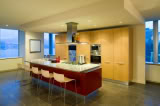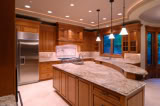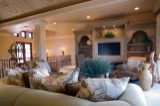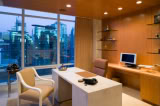Recessed Lighting
 |  |
|---|---|
 |  |
Recessed lights are energy-efficient and provide an inexpensive way to update the appearance of your home. The lights can accent any room in your home and can increase the amount of light, highlight artwork, create dramatic shadows on walls and so much more. In the photos above you can see the various ways recessed lights are used to open up a room and how they make the rooms look and feel sophisticated and bright. So if you are looking for a clean, cool and sophisticated look for your home then seriously consider recessed lighting.
Since recessed lights are hidden, ceiling lines are not broken and the rooms in your home feel and look more open and spacious. Recessed lights also provide the option of having a dimmer installed so that you can control how much light you want. This energy-saving benefit can add ambiance to your room and allow you to create subtle amounts of light to go with your mood. Choosing airtight fixtures for your recessed lights will also increase your energy savings, as they help to reduce energy loss. Homeowners often choose recessed lighting when they want to light a room in an elegant way without the lights obstructing the design of the room. Recessed lights come in numerous shapes, sizes and colors, which allows you to be creative with your trimming choices. Check out Lamps Plus, where you can view hundreds of different recessed light trimmings.
Some Considerations:
- If you will be adding recessed lights to your already-existing home (as opposed to new construction) and you have ceiling insulation, you must be careful to only choose a fixture that is rated for use near insulation. It's a safety must that the fixture be IC housing rated.
- It's better not to consider recessed lighting if you have ceilings of concrete, ceilings with ornate plasterwork or delicate molding details. These type of ceilings are not good candidates for recessed lighting and you could end up with a mess instead of beautiful new lights.
- Installing your own recessed lights requires that you know about electrical wiring. If you don't, then don't take any chances and find a reliable electrician to do the job for you!
- Recessed lighting is often the safest choice for the interior of closets. Many house fires have been caused by objects falling from shelves and coming into contact with unshielded bulbs in surface-mounted fixtures.
Light Bulb Best Bets for Recessed Lights:
- Incandescent bulbs, also known as "A" bulbs, have been used for years in recessed lighting fixtures, They are inexpensive and good for general light or wall washing with the use of reflectors. Keep in mind, though, that these bulbs are inefficient and may even be outlawed within the next few years.
- "R" bulbs are most common and have a reflective surface included on the back of the bulb.
- Halogen bulbs offer a clean, white light and are available in both flood and spot types in sizes to fit 4-, 5- or 6-inch fixtures.
- Low-voltage halogen bulbs have a long life and put out more light than incandescent bulbs, but they require the use of transformers and special low-voltage housing.
Placement Tips:
- Avoid placing lights too close to each other or you will create an "airport runway" effect, which you certainly do not want for your home!
- Place the recessed lighting at approximately 12-18 inches from the front of the object that you want to light.
- The recessed lighting rule of thumb is that 4-inch fixtures should be placed at least 4 feet apart and 6-inch fixtures about 6 feet apart.
- When lighting a three-dimensional object such as a fireplace, sculpture or flower arrangement, it is more effective to light it from two or three different angles.
Looking for a Pro? Call us (866) 441-6648

Electrical Average Costs
Electricians Experiences

Electrical Wiring For Our New Shed

Ceiling Fan Replacement By A Fast, Knowledgeable And Reasonable Electrician



